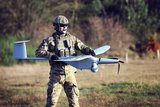Russian bombers and fighters intercepted off Alaska
US fighters intercepted six Russian military aircraft in international airspace west of Alaska, and shadowed them until they exited the area, the North American Air Defense Command said on 21 May.
The Russian aircraft included two Tu-95 strategic bombers, which were intercepted 20 May by two F-22 fighters, the command said. A second group of two Tu-95 bombers and two Su-35 fighters were also intercepted by a pair of F-22 fighters, it added.
An AWACS surveillance plane monitored the operations, NORAD said, adding that the Russian aircraft were in international airspace throughout.
They were picked up as they entered the Alaska Air Defense Identification Zone, a perimeter line that lies outside national airspace but within which air traffic is kept under constant surveillance to reduce response times in case of a hostile threat.
‘Our ability to deter and defeat threats to our citizens and vital infrastructure starts with detecting, tracking, and positively identifying aircraft in our airspace,’ NORAD's commander, General Terrence O'Shaughnessy, said. ‘We are on alert 24 hours a day, seven days a week, 365 days a year.’
The US has four Air Defense Identification Zones. The Alaska zone extends about 200 miles (320 kilometres) from the state's coast.
More from Defence Notes
-
![Taiwan approved for $11 billion weapon purchase from US]()
Taiwan approved for $11 billion weapon purchase from US
The US State Department’s approval of a multi-billion-dollar sale of weapons to Taiwan includes tactical mission networks equipment, uncrewed aerial systems, artillery rocket systems and self-propelled howitzers as well as anti-tank guided missiles.
-
![Ireland spells out $2.3 billion shopping list in five-year defence spending plan]()
Ireland spells out $2.3 billion shopping list in five-year defence spending plan
Ireland’s multi-annual investment in capital defence spending is set to rise from €300m in 2026 to €360m in 2029–2030 with major upgrades across land, air, maritime and cyber domains.
-
![Canada to deepen integration of multi-domain capabilities to strengthen its defences]()
Canada to deepen integration of multi-domain capabilities to strengthen its defences
The Canadian Department of National Defence has created new organisations to manage the procurement and integration of all-domain solutions and allocated US$258.33 million to strengthen production capacities.
-
![US National Security Strategy prioritises advanced military capabilities and national industry]()
US National Security Strategy prioritises advanced military capabilities and national industry
The 2025 NSS has emphasised investment in the US nuclear and air defence inventory and national industry, but it leaves multiple unanswered questions on how the White House will implement this approach.
-
![Canada set to look away from its neighbour and across the Atlantic for partners]()
Canada set to look away from its neighbour and across the Atlantic for partners
While non-EU UK struggles to join the Security Action for Europe initiative, which provides loans for defence programmes, Canada has become the first country outside Europe to get access – and did so for a nominal fee.
-
![NATO experiments with solutions to integrate networks, AI and uncrewed systems]()
NATO experiments with solutions to integrate networks, AI and uncrewed systems
During the latest edition of the NATO DiBaX, the alliance tested multiple capabilities to inform requirements for future efforts.


























